Can Childcare Work Be Designed to Promote High Intensity Physical Activity for Improved Fitness and Health? A Proof of Concept Study of the Goldilocks Principle
Abstract
1. Introduction
2. Materials and Methods
2.1. Data Protection and Ethical Approval
2.2. The Process of Designing Alternative Work Tasks—The Goldilocks-Games
- Step 1:
- We retrieved evidence from two childcare institutions participating in a previous study by our research group [23]. Based on this knowledge and a dialogue with childcare workers and managers, we identified what constituted a regular workday, including identifying main work tasks, and where different activities occurred. This gave an overview of childcare work and an idea of the potential to achieve a ‘just right’ balance of exertion and recovery.
- Step 2:
- We collected additional data on 15 childcare workers (age, M 38 years, SD 11; 60% female) at the two institutions engaged in step 1. Data was collected regarding BMI (M 26 kg/m2, SD 4), self-reported physical activity level, and heart rate for five consecutive days, the latter using ambulatory sensors. This provided a basis to assess the workers’ health status, and physical behavior(s) that could influence health.
- Step 3:
- Based on our understanding of the childcare workers’ (i) work tasks, (ii) physical activity behavior during work hours, and (iii) health status, we determined that a relevant health-related goal would be to improve their cardiorespiratory fitness. To achieve this goal, we focused on promoting HIPA behavior when the childcare workers play pedagogical games with the children.
- Step 4:
- The process of modifying pedagogical games in childcare began by identifying initiatives that could increase HIPA in childcare, based on scientific literature [34,35], field observations and feedback from childcare workers. Then, an iterative process (shown by circulating arrows, Figure 1) was used to develop pedagogical games (i.e., modify a work task) and test them in daily childcare work (i.e., assessing their potential to change work behaviors). The field tests were performed on four childcare workers at two separate institutions, none of which were included in the main study. The field tests included observations, questionnaires and measurements using ambulatory sensors to assess the extent to which the games lead to HIPA, and whether it was feasible for the childcare workers to perform the games in the context of acting as active role models for the children. In this process, we developed and tested six games. Three of the six games did not show a potential to increase HIPA, and were therefore excluded. Finally, we presented the three remaining games to an expert panel comprising members from childcare organizations, union representatives, employers associations’ representatives and government occupational health consultants, which added specific suggestions on how to tailor the games to the needs, context, and work conditions in childcare. This included adapting the games to better incorporate the new and improved educational curriculum (i.e., six politically determined objectives) for childcare work in Denmark [24].
2.3. Study Design
- Day 1:
- Began with anthropometric measurements and a questionnaire-based interview with the childcare workers. After that, we instructed the children to play the Goldilocks-games with the childcare workers joining in together with the children, thus introducing the childcare workers to the games.
- Day 2:
- A regular workday, where the childcare workers were told to perform their work as usual.
- Day 3:
- Began with the childcare workers conducting the Goldilocks-games with the children without assistance from the research team. A member of the research team observed the Goldilocks-games and noted information on participation by the childcare workers, and contextual factors of relevance. Also, the childcare workers were asked to rate their perceived exertion while performing the games. After having performed the games, the childcare workers were asked about the feasibility of the games, and had their cardiorespiratory fitness assessed. Heart rate was monitored during day (2) and (3).
2.4. Participants
2.5. Worker Perceptions of Feasibility and Exertion
2.6. Participation and Contextual Factors
2.7. Heart Rate
2.8. Sample Size
2.9. Statistical Methods
3. Results
3.1. Participants Flow
3.2. Demographics and Fitness
3.3. Worker Perceptions of Goldilocks-Games Feasibility and Exertion
3.4. Researcher Observations of Contextual Factors during the Goldilocks-Games
3.5. Heart Rate Measurements (HIPA during Goldilocks-Games and Regular Workday)
4. Discussion
4.1. Strengths and Limitations
4.2. Practical Implications
5. Conclusions
Author Contributions
Funding
Acknowledgments
Conflicts of Interest
Appendix A
| Original Game | Description | Re-Designed Game | Modifications |
|---|---|---|---|
| Catching tails | Two children are randomly announced as catchers. The remaining children each attach one tail. The catchers countdown from ten and then run to collect all the tails from the children. The childcare workers assist in attaching tails and start and stop the game. | Egg hunt 1,2,3,4,5 | The childcare workers are announced as catchers 1. All the children attach eggs to their shirts/pants. The childcare workers draw an activity card and countdown by performing 1–9 repetitions of the drawn activity (e.g., burpees, air boxing or air squats), while the children runs away 2,3. The childcare workers then have to collect all the eggs by chasing and catching each child 1. The game is restarts for several rounds 4. |
| Circle run | Two equal sized teams of children starts at opposing sides of a circle of cones. The objective is to catch the opposing team by running in the same direction around the circle. The childcare workers set up the circle, judge who is caught and restarts the game. | Rabbit hunt 1,2,3,4,5 | The childcare workers and a group of children starts at opposing sides of a circle of cones. The childcare workers have to catch the children running in the same direction as the children around the circle 1. When a child is caught, the childcare workers perform an activity (e.g., burpee, air boxing, air squats), giving the remaining children the opportunity to run forward 2,3. When all children are caught the game restarts 4. |
| Train | All children are paired and walks hand-in-hand in a straight line. The childcare workers walks at the front and the end of the line. | Goldilocks train 1,3,4,5 | All children are paired and walks hand-in-hand in a straight line. The childcare workers walks in the front. The childcare workers walk to the back of the line, and collects one child each from their side of the line 1,3. The childcare worker and the child (holding hands) run together to the front of the line 1. This process is continued until a predetermined destination is reached 4. |
Appendix B
Appendix B.1. Game 1: Egg hunt
- Exercises: Burpees, squat jumps, jumping jacks, air boxing with high knees.
- Materials: Laminated eggs, clamps, exercise and number cards.
- Duration: 10–15 min.

Appendix B.2. Game 2: The Rabbit Hunt
- Exercise: Burpees, squats, jumping jacks.
- Materials: Cones.
- Duration: 10–15 min.
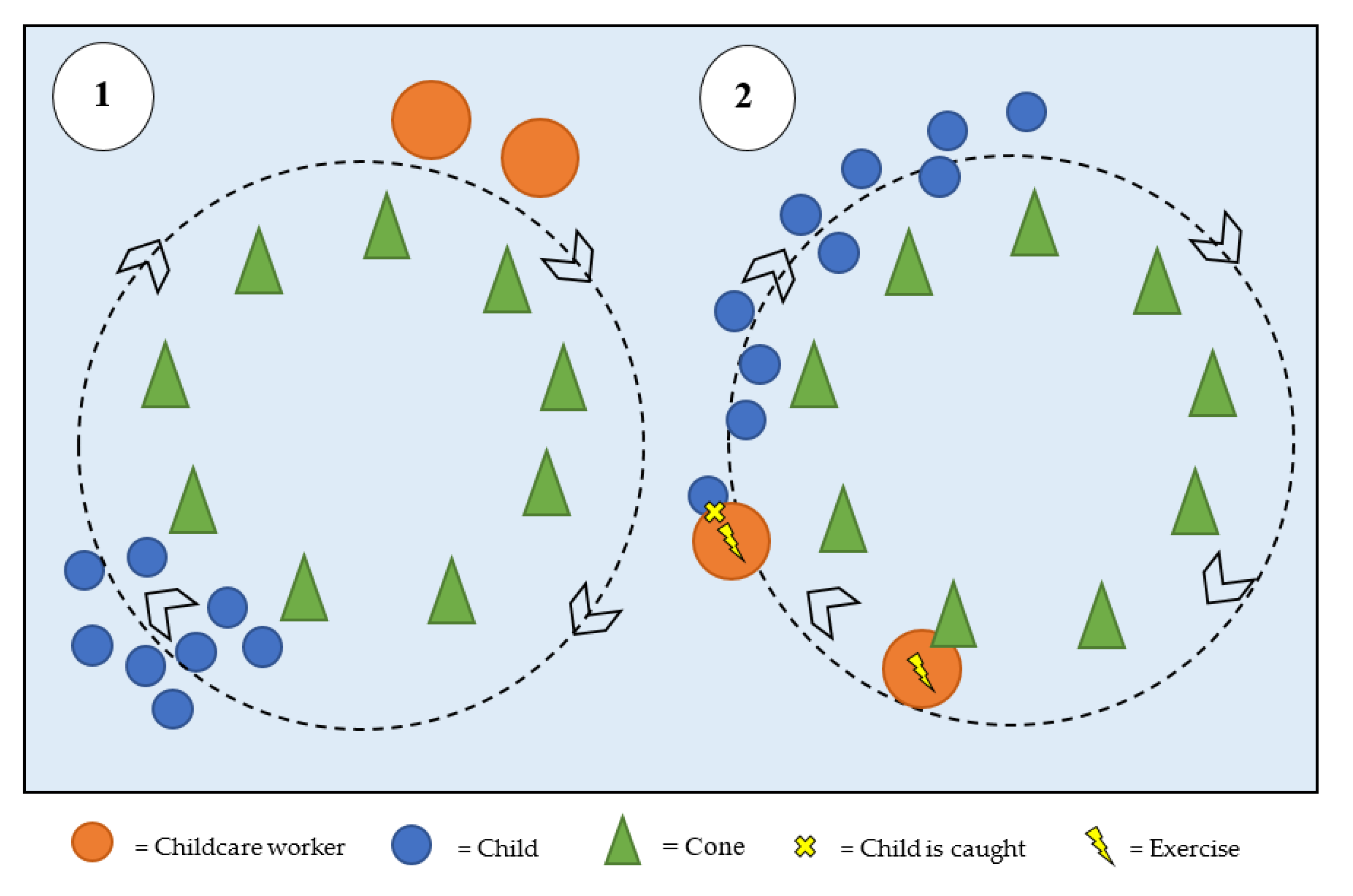
Appendix B.3. Game 3: The Goldilocks Train
- Materials: None.
- Duration: 10–15 min.
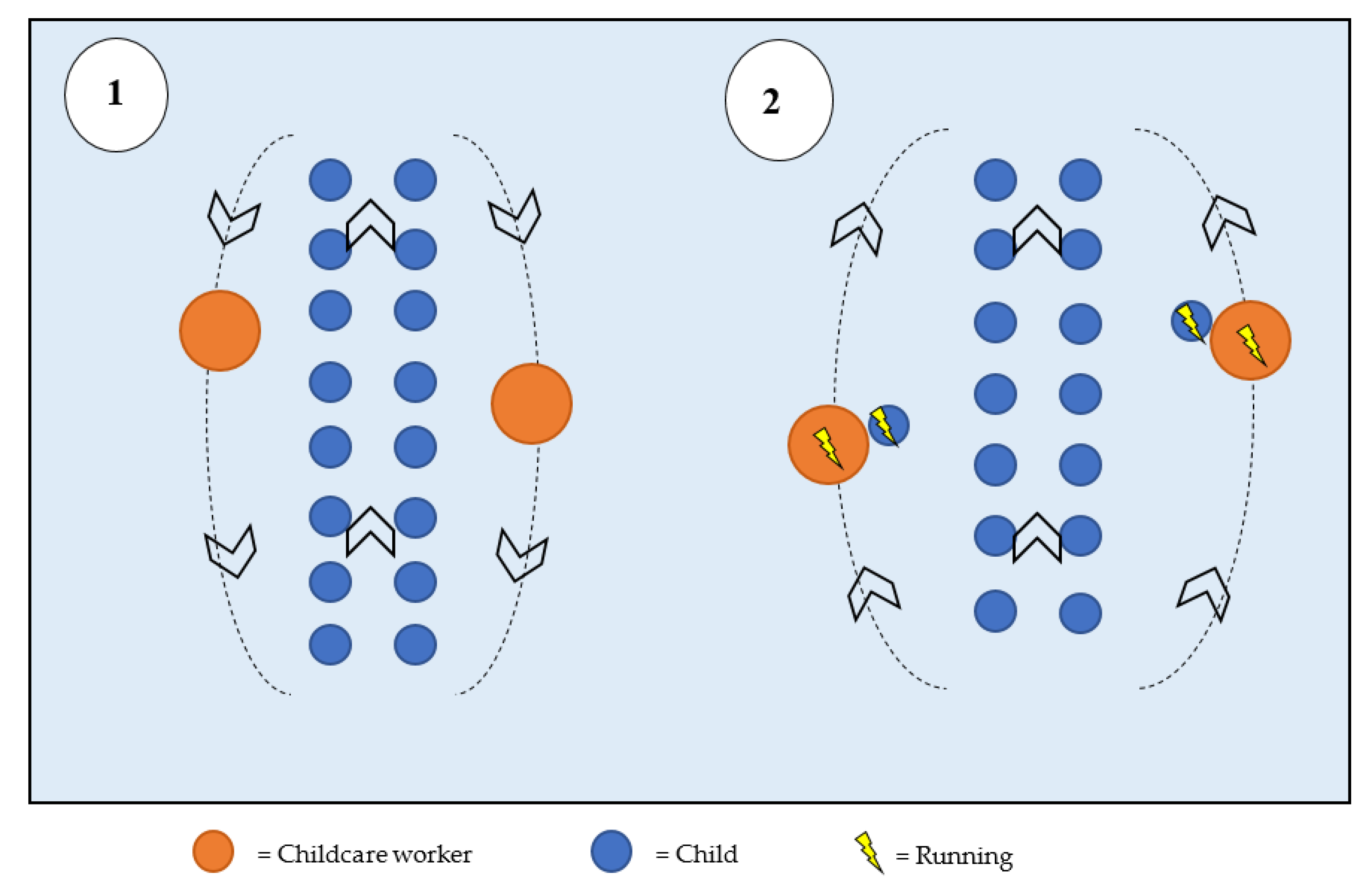
Appendix C
| Q1 | ||||
| Fitness Level | Workers (n) | Feasible (%) | Partially feasible (%) | Unfeasible (%) |
| Above average | 4 | 83 | 17 | 0 |
| Average | 12 | 67 | 33 | 0 |
| Below average | 3 | 89 | 11 | 0 |
| Q2 | ||||
| Fitness level | Workers (n) | Feasible (%) | Partially feasible (%) | Unfeasible (%) |
| Above average | 4 | 67 | 33 | 0 |
| Average | 12 | 75 | 19 | 6 |
| Below average | 3 | 67 | 11 | 22 |
| Q1 | ||||
| Smoker | Workers (n) | Feasible (%) | Partially feasible (%) | Unfeasible (%) |
| Yes | 7 | 62 | 38 | 0 |
| No | 12 | 81 | 19 | 0 |
| Q2 | ||||
| Smoker | Workers (n) | Feasible (%) | Partially feasible (%) | Unfeasible (%) |
| Yes | 7 | 57 | 43 | 0 |
| No | 12 | 81 | 8 | 11 |
Appendix D
| Smoker | Workers (n) | Borg (SD) |
| Yes | 7 | 5.0 (1.4) |
| No | 12 | 4.9 (1.5) |
| Fitness Level | Workers (n) | Borg (SD) |
| Above average | 4 | 4.6 (1.7) |
| Average | 12 | 4.6 (1.2) |
| Below average | 3 | 6.3 (1.2) |
References
- Margaras, V. Demographic Trends in EU Regions. Available online: https://ec.europa.eu/futurium/en/system/files/ged/eprs-briefing-633160-demographic-trends-eu-regions-final.pdf (accessed on 30 July 2020).
- Lee, R.; Ferguson, R.W.; Auerbach, A.J.; Boersch-Supan, A.; Bongaarts, J.; Collins, S.M.; Lucas, C.M.; Lucas, D.J.; Mitchell, O.S.; Nordhaus, W.D.; et al. Aging and the Macroeconomy: Long-Term Implications of an Older Population; The National Academies Press: Washington, DC, USA, 2012. [Google Scholar]
- Holtermann, A.; Mortensen, O.S.; Burr, H.; Søgaard, K.; Gyntelberg, F.; Suadicani, P. Physical demands at work, physical fitness, and 30-year ischaemic heart disease and all-cause mortality in the Copenhagen Male Study. Scand. J. Work. Environ. Health 2010, 36, 357–365. [Google Scholar] [CrossRef] [PubMed]
- Written, K. Geographies of Obesity; Routledge: London, UK, 2010. [Google Scholar]
- Buchbinder, R.; van Tulder, M.; Öberg, B.; Costa, L.M.; Woolf, A.; Schoene, M.; Croft, P. Low back pain: A call for action. Lancet 2018, 391, 2384–2388. [Google Scholar] [CrossRef]
- Burton, J. WHO Healthy Workplace Framework and Model: Background and Supporting Literature and Practice. Available online: https://www.who.int/occupational_health/healthy_workplace_framework.pdf (accessed on 30 July 2020).
- Holtermann, A.; Coenen, P.; Krause, N. The paradoxical health effects of occupational versus leisure-time physical activity. In Handbook of Socioeconomic Determinants of Occupational Health. Handbook Series in Occupational Health Sciences; Theorell, T., Ed.; Springer: Cham, Switzerland, 2020. [Google Scholar]
- Constitution of the World Health Organization. Available online: https://apps.who.int/gb/bd/PDF/bd47/EN/constitution-en.pdf?ua=1 (accessed on 15 September 2020).
- Warburton, D.E.; Bredin, S.S. Reflections on physical activity and health: What should we recommend? Can. J. Cardiol. 2016, 32, 495–504. [Google Scholar] [CrossRef] [PubMed]
- Warburton, D.E.; Nicol, C.W.; Bredin, S.S. Health benefits of physical activity: The evidence. CMAJ 2006, 174, 801–809. [Google Scholar] [CrossRef] [PubMed]
- Gillen, J.B.; Martin, B.J.; MacInnis, M.J.; Skelly, L.E.; Tarnopolsky, M.A.; Gibala, M.J. Twelve weeks of sprint interval training improves indices of cardiometabolic health similar to traditional endurance training despite a five-fold lower exercise volume and time commitment. PLoS ONE 2016, 11, e0154075. [Google Scholar] [CrossRef] [PubMed]
- Holtermann, A.; Mathiassen, S.E.; Straker, L. Promoting health and physical capacity during productive work: The Goldilocks Principle. Scand. J. Work. Environ. Health 2019, 45, 90–97. [Google Scholar] [CrossRef] [PubMed]
- Straker, L.; Mathiassen, S.E.; Holtermann, A. The ‘Goldilocks Principle’: Designing physical activity at work to be ‘just right’ for promoting health. Br. J. Sports Med. 2018, 52, 818–819. [Google Scholar] [CrossRef] [PubMed]
- Mathiassen, S.E. Diversity and variation in biomechanical exposure: What is it, and why would we like to know? Appl. Ergon. 2006, 37, 419–427. [Google Scholar] [CrossRef]
- Straker, L.; Mathiassen, S.E. Increased physical work loads in modern work—A necessity for better health and performance? Ergonomics 2009, 52, 1215–1225. [Google Scholar] [CrossRef]
- Tucker, P. The impact of rest breaks upon accident risk, fatigue and performance: A review. Work Stress 2003, 17, 123–137. [Google Scholar] [CrossRef]
- Jørgensen, M.B.; Gupta, N.; Korshøj, M.; Lagersted-Olsen, J.; Villumsen, M.; Mortensen, O.S.; Skotte, J.; Søgaard, K.; Madeleine, P.; Samani, A.; et al. The DPhacto cohort: An overview of technically measured physical activity at work and leisure in blue-collar sectors for practitioners and researchers. Appl. Ergon. 2019, 77, 29–39. [Google Scholar] [CrossRef] [PubMed]
- Cumming, T. Early childhood educators’ well-being: An updated review of the literature. Early Child Educ. J. 2016, 45, 583–593. [Google Scholar] [CrossRef]
- Linnan, L.; Arandia, G.; Bateman, L.A.; Vaughn, A.; Smith, N.; Ward, D. The health and working conditions of women employed in child care. Int. J. Environ. Res. Public Health 2017, 14, 283. [Google Scholar] [CrossRef] [PubMed]
- Otten, J.J.; Bradford, V.A.; Stover, B.; Hill, H.D.; Osborne, C.; Getts, K.; Seixas, N. The culture of health in early care and education: Workers’ wages, health, and job characteristics. Health Aff. 2019, 38, 709–720. [Google Scholar] [CrossRef]
- Tal og Fakta om Arbejdsmiljøet. Available online: https://arbejdsmiljodata.nfa.dk/ (accessed on 30 July 2020).
- Ward, D.S.; Vaughn, A.E.; Hales, D.; Viera, A.J.; Gizlice, Z.; Bateman, L.A.; Grummon, A.H.; Arandia, G.; Linnan, L.A. Workplace health and safety intervention for child care staff: Rationale, design, and baseline results from the CARE cluster randomized control trial. Contemp. Clin. Trials 2018, 68, 116–126. [Google Scholar] [CrossRef]
- Holtermann, A.; Hendriksen, P.F.; Schmidt, K.G.; Svendsen, M.J.; Rasmussen, C.D.N. Physical work demands of childcare workers in Denmark: Device-based measurements and workplace observations among 199 childcare workers from 16 day nurseries. Ann. Work Expo. Health 2020, 64, 586–595. [Google Scholar] [CrossRef]
- National Reforms in Early Childhood Education and Care. Available online: https://eacea.ec.europa.eu/national-policies/eurydice/content/national-reforms-early-childhood-education-and-care-18_en (accessed on 30 July 2020).
- The Strengthened Pedagogical Curriculum. Framework and Content. Available online: https://emu.dk/sites/default/files/2020-01/Den%20styrkede%20pædagogiske%20læreplan_engelsk.pdf (accessed on 30 July 2020).
- Kusma, B.; Mache, S.; Quarcoo, D.; Nienhaus, A.; Groneberg, D.A. Educators’ working conditions in a day care centre on ownership of a non-profit organization. J. Occup. Med. Toxicol. 2011, 6, 36. [Google Scholar] [CrossRef]
- Adamo, K.B.; Wasenius, N.S.; Grattan, K.P.; Harvey, A.L.J.; Naylor, P.-J.; Barrowman, N.J.; Goldfield, G.S. Effects of a preschool intervention on physical activity and body composition. J. Pediatr. 2017, 188, 42–49. [Google Scholar] [CrossRef]
- Tandon, P.S.; Downing, K.L.; Saelens, B.E.; Christakis, D.A. Two approaches to increase physical activity for preschool children in child care centers: A matched-pair cluster-randomized trial. Int. J. Environ. Res. Public Health 2019, 16, 4020. [Google Scholar] [CrossRef]
- Tucker, P.; Vanderloo, L.M.; Johnson, A.M.; Burke, S.M.; Irwin, J.D.; Gaston, A.; Driediger, M.; Timmons, B.W. Impact of the supporting physical activity in the childcare environment (SPACE) intervention on preschoolers’ physical activity levels and sedentary time: A single-blind cluster randomized controlled trial. Int. J. Behav. Nutr. Phys. Act. 2017, 14, 120. [Google Scholar] [CrossRef]
- Brazendale, K.; Chandler, J.L.; Beets, M.W.; Weaver, R.G.; Beighle, A.; Huberty, J.L.; Moore, J.B. Maximizing children’s physical activity using the LET US Play principles. Prev. Med. 2015, 76, 14–19. [Google Scholar] [CrossRef] [PubMed]
- Cheung, P. Teachers as role models for physical activity: Are preschool children more active when their teachers are active? Sage J. 2020, 26, 101–110. [Google Scholar] [CrossRef]
- Moher, D.; Hopewell, S.; Schulz, K.; Montori, V.; Gøtzsche, P.; Devereaux, P.; Elbourne, D.; Egger, M.; Altman, D. CONSORT 2010 explanation and elaboration: Updated guidelines for reporting parralel group randomised trials. J. Clin. Epidemiol. 2010, 63, e1–e37. [Google Scholar] [CrossRef] [PubMed]
- Hoffmann, T.; Glasziou, P.; Boutron, I.; Milne, R.; Perera, P.; Moher, D.; Altman, D.; Barbour, V.; Macdonald, H.; Johnston, M.; et al. Better reporting of interventions: Template for intervention description and replication (TIDieR) checklist and guide. BMJ 2014, 348, 237. [Google Scholar] [CrossRef]
- Van Zandvoort, M.; Tucker, P.; Irwin, J.D.; Burke, S.M. Physical activity at daycare: Issues, challenges and perspectives. Early Years 2010, 30, 175–188. [Google Scholar] [CrossRef]
- Gagné, C.; Harnois, I. How to motivate childcare workers to engage preschoolers in physical activity. J. Phys. Act. Health 2014, 11, 364–374. [Google Scholar] [CrossRef]
- Björkman, F.; Ekblom-Bak, E.; Ekblom, Ö.; Ekblom, B. Validity of the revised Ekblom Bak cycle ergometer test in adults. Eur. J. Appl. Physiol. 2016, 116, 1627–1638. [Google Scholar] [CrossRef]
- Ekblom-Bak, E.; Björkman, F.; Hellenius, M.L.; Ekblom, B. A new submaximal cycle ergometer test for prediction of VO2max. Scand. J. Med. Sci. Sports 2014, 24, 319–326. [Google Scholar] [CrossRef]
- Hettiarachchi, I.T.; Hanoun, S.; Nahavandi, D.; Nahavandi, S. Validation of Polar OH1 optical heart rate sensor for moderate and high intensity physical activities. PLoS ONE 2019, 14, e0217288. [Google Scholar] [CrossRef]
- Schubert, M.M.; Clark, A.; De La Rosa, A.B. The Polar® OH1 optical heart rate sensor is valid during moderate-vigorous exercise. Sports Med. Int. Open 2018, 2, e67–e70. [Google Scholar] [CrossRef]
- Maximal oxygen uptake reference values for the Ekblom Bak test. Available online: https://www.gih.se/Global/3_forskning/fysiologi/elinekblombak/Reference_values_180319_en.pdf (accessed on 30 July 2020).
- Williams, N. The borg rating of perceived exertion (rpe) scale. Occup. Med. 2017, 67, 404–405. [Google Scholar] [CrossRef]
- Kristiansen, J.; Korshøj, M.; Skotte, J.H.; Jespersen, T.; Søgaard, K.; Mortensen, O.S.; Holtermann, A. Comparison of two systems for long-term heart rate variability monitoring in free-living conditions—A pilot study. Biomed. Eng. Online 2011, 10, 27. [Google Scholar] [CrossRef] [PubMed]
- Skotte, J.; Korshøj, M.; Kristiansen, J.; Hanisch, C.; Holtermann, A. Detection of physical activity types using triaxial accelerometers. J. Phys. Act. Health 2014, 11, 76–84. [Google Scholar] [CrossRef] [PubMed]
- Korshøj, M.; Krustrup, P.; Jespersen, T.; Søgaard, K.; Skotte, J.H.; Holtermann, A. A 24-h assessment of physical activity and cardio-respiratory fitness among female hospital cleaners: A pilot study. Ergonomics 2013, 56, 935–943. [Google Scholar] [CrossRef] [PubMed]
- Tanaka, H.; Monahan, K.D.; Seals, D.R. Age-predicted maximal heart rate revisited. J. Am. Coll. Cardiol. 2001, 37, 153–156. [Google Scholar] [CrossRef]
- Gormley, S.E.; Swain, D.P.; High, R.; Spina, R.J.; Dowling, E.A.; Kotipalli, U.S.; Gandrakota, R. Effect of intensity of aerobic training on VO2max. Med. Sci. Sports Exerc. 2008, 40, 1336–1343. [Google Scholar] [CrossRef] [PubMed]
- Bacon, A.P.; Carter, R.E.; Ogle, E.A.; Joyner, M.J. VO2max trainability and high intensity interval training in humans: A meta-analysis. PLoS ONE 2013, 8, e73182. [Google Scholar] [CrossRef]
- Whitley, E.; Ball, J. Statistics review 4: Sample size calculations. Crit. Care 2002, 6, 335–341. [Google Scholar] [CrossRef]
- Powell, K.E.; Paluch, A.E.; Blair, S.N. Physical activity for health: What kind? How much? How intense? On top of what? Annu. Rev. Public Health 2011, 32, 349–365. [Google Scholar] [CrossRef]
- Warburton, D.E.R.; Bredin, S.S.D. Health benefits of physical activity: A systematic review of current systematic reviews. Curr. Opin. Cardiol. 2017, 32, 541–556. [Google Scholar] [CrossRef]
- R-Core-Team. R: A Language and Environment for Statistical Computing. Available online: https://www.R-project.org/ (accessed on 30 July 2020).
- Gupta, N.; Rasmussen, C.L.; Holtermann, A.; Mathiassen, S.E. Time-based data in occupational studies: The whys, the hows, and some remaining challenges in compositional data analysis (CoDA). Ann. Work Expo. Health 2020. [Google Scholar] [CrossRef] [PubMed]
- Van den Boogaart, K.; Tolosana-Delgado, R. “Compositions”: A unified R package to analyze compositional data. Comput. Geosci. UK 2008, 34, 320–338. [Google Scholar] [CrossRef]
- Aitchison, J. The statistical analysis of compositional data. J. R. Stat. Soc. Ser. B Methodol. 1982, 44, 139–160. [Google Scholar] [CrossRef]
- Egozcue, J.J.; Pawlowsky-Glahn, V.; Mateu-Figueras, G.; Barceló-Vidal, C. Isometric logratio transformations for compositional data analysis. Math. Geosci. 2003, 35, 279–300. [Google Scholar] [CrossRef]
- Pedisic, Z.; Dumuid, D.; Olds, T. Integrating sleep, sedentary behaviour, and physical activity research in the emerging field of time-use epidemiology: Definitions, concepts, statistical methods, theoretical framework, and future directions. Kinesiology 2017, 49, 252–269. [Google Scholar]
- Palarea-Albaladejo, J.; Martín-Fernández, J.Z. Compositions-R package for multivariate imputation of left-censored data under a compositional approach. Chemometr. Intell. Lab. 2015, 143, 85–96. [Google Scholar] [CrossRef]
- Palarea-Albaladejo, J.; Martín-Fernández, J.A. A modified EM alr-algorithm for replacing rounded zeros in compositional data sets. Comput. Geosci. UK 2008, 34, 902–917. [Google Scholar] [CrossRef]
- Rasmussen, C.D.N.; Sørensen, O.H.; van der Beek, A.J.; Holtermann, A. The effect of training for a participatory ergonomic intervention on physical exertion and musculoskeletal pain among childcare workers (the TOY-project)—a wait-list cluster-randomized controlled trial. Scand. J. Work. Environ. Health 2020, 46, 429–436. [Google Scholar] [CrossRef]
- Jenkins, E.M.; Nairn, L.N.; Skelly, L.E.; Little, J.P.; Gibala, M.J. Do stair climbing exercise “snacks” improve cardiorespiratory fitness? Appl. Physiol. Nutr. Metab. 2019, 44, 681–684. [Google Scholar] [CrossRef]
- Ramos, J.S.; Dalleck, L.C.; Tjonna, A.E.; Beetham, K.S.; Coombes, J.S. The impact of high-intensity interval training versus moderate-intensity continuous training on vascular function: A systematic review and meta-analysis. Sports Med. 2015, 45, 679–692. [Google Scholar] [CrossRef]
- Tarp, J.; Child, A.; White, T.; Westgate, K.; Bugge, A.; Grøntved, A.; Wedderkopp, N.; Andersen, L.B.; Cardon, G.; Davey, R.; et al. Physical activity intensity, bout-duration, and cardiometabolic risk markers in children and adolescents. Int. J. Obes. 2018, 42, 1639–1650. [Google Scholar] [CrossRef] [PubMed]
- Krustrup, P.; Aagaard, P.; Nybo, L.; Petersen, J.; Mohr, M.; Bangsbo, J. Recreational football as a health promoting activity: A topical review. Scand. J. Med. Sci. Sports 2010, 20, 1–13. [Google Scholar] [CrossRef] [PubMed]
- Aadahl, M.; Kjaer, M.; Jørgensen, T. Perceived exertion of physical activity: Negative association with self-rated fitness. Scand. J. Public Health 2007, 35, 403–409. [Google Scholar] [CrossRef] [PubMed]
- Wells, R.; Norman, R.; Frazer, M.; Laing, A.; Cole, D.; Kerr, M. Participative Ergonomic Blueprint; Institute for Work & Health: Toronto, ON, Canada, 2003. [Google Scholar]
- Parak, J.; Korhonen, I. Accuracy of Firstbeat Bodyguard 2 Beat-To-Beat Heart Rate Monitor. Available online: https://assets.firstbeat.com/firstbeat/uploads/2015/10/white_paper_bodyguard2_final.pdf (accessed on 30 July 2020).
- Mann, T.; Lamberts, R.P.; Lambert, M.I. Methods of prescribing relative exercise intensity: Physiological and practical considerations. Sports Med. 2013, 43, 613–625. [Google Scholar] [CrossRef] [PubMed]
- Lidegaard, M.; Lerche, A.F.; Munch, P.K.; Schmidt, K.G.; Rasmussen, C.L.; Rasmussen, C.D.N.; Mathiassen, S.E.; Straker, L.; Holtermann, A. Can childcare work be designed to promote moderate and vigorous physical activity, cardiorespiratory fitness and health? Study protocol for the Goldilocks-childcare randomised controlled trial. BMC Public Health 2020, 20, 237. [Google Scholar] [CrossRef]
- Linnan, L.A.; Vaughn, A.E.; Smith, F.T.; Westgate, P.; Hales, D.; Arandia, G.; Neshteruk, C.; Willis, E.; Ward, D.S. Results of caring and reaching for health (CARE): A cluster-randomized controlled trial assessing a worksite wellness intervention for child care staff. Int. J. Behav. Nutr. Phys. Act. 2020, 17, 64. [Google Scholar] [CrossRef]
- Proper, K.I.; van den Heuvel, S.G.; de Vroome, E.M.; Hildebrandt, V.H.; van der Beek, A.J. Dose-response relation between physical activity and sick leave. Br. J. Sports Med. 2006, 40, 173–178. [Google Scholar] [CrossRef]
- Jørgensen, M.B.; Villadsen, E.; Burr, H.; Mortensen, O.S.; Holtermann, A. Does workplace health promotion in Denmark reach relevant target groups? Health Promot. Int. 2015, 30, 318–327. [Google Scholar] [CrossRef]

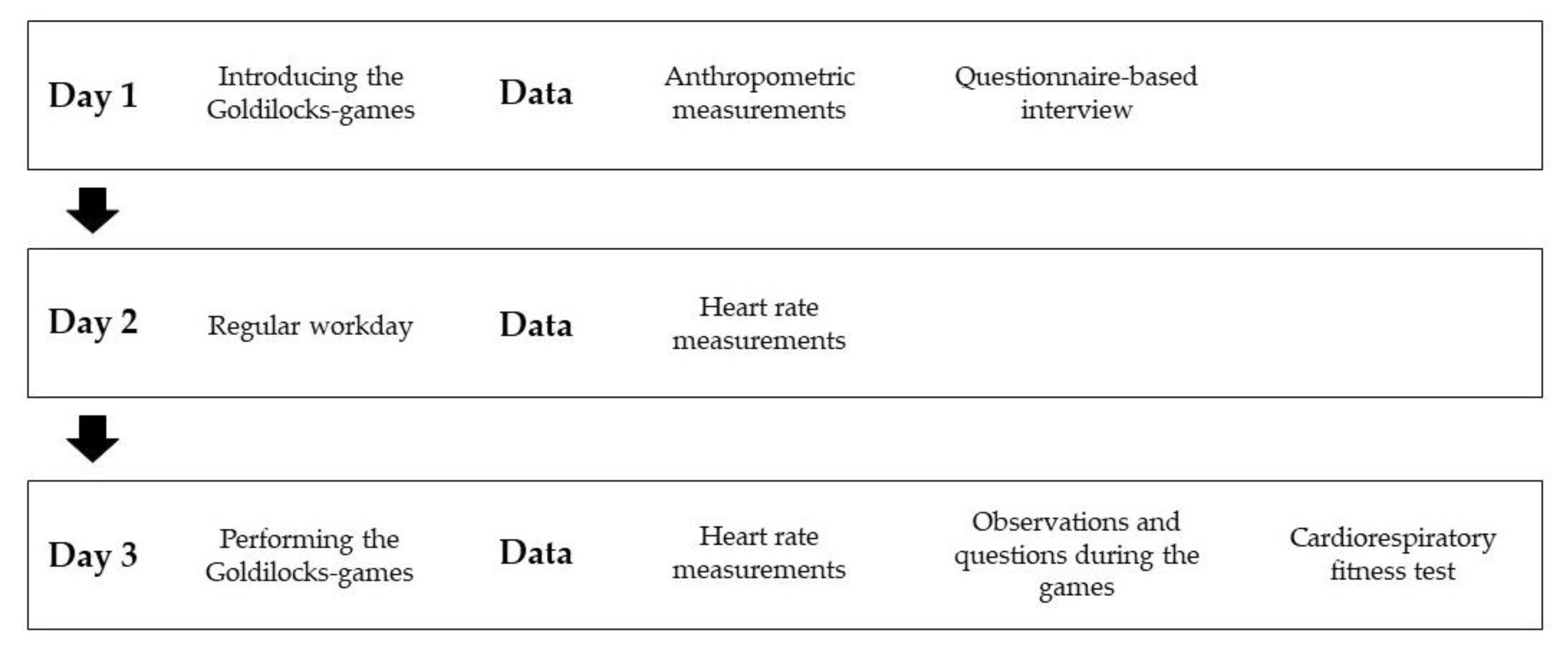
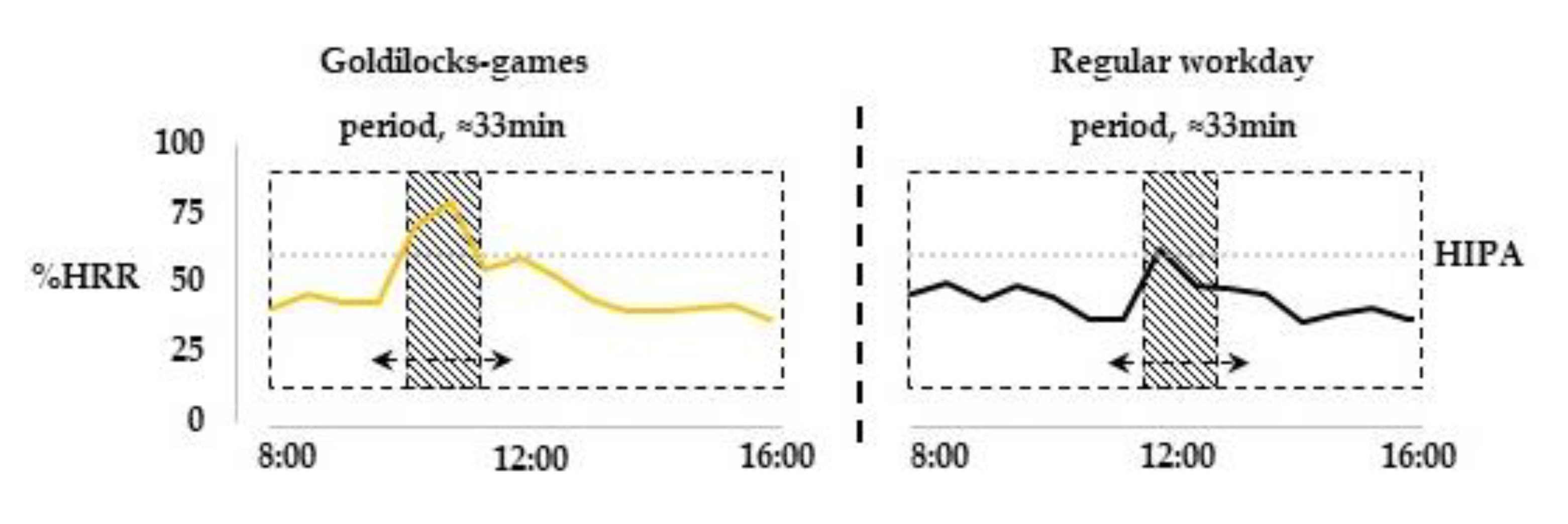
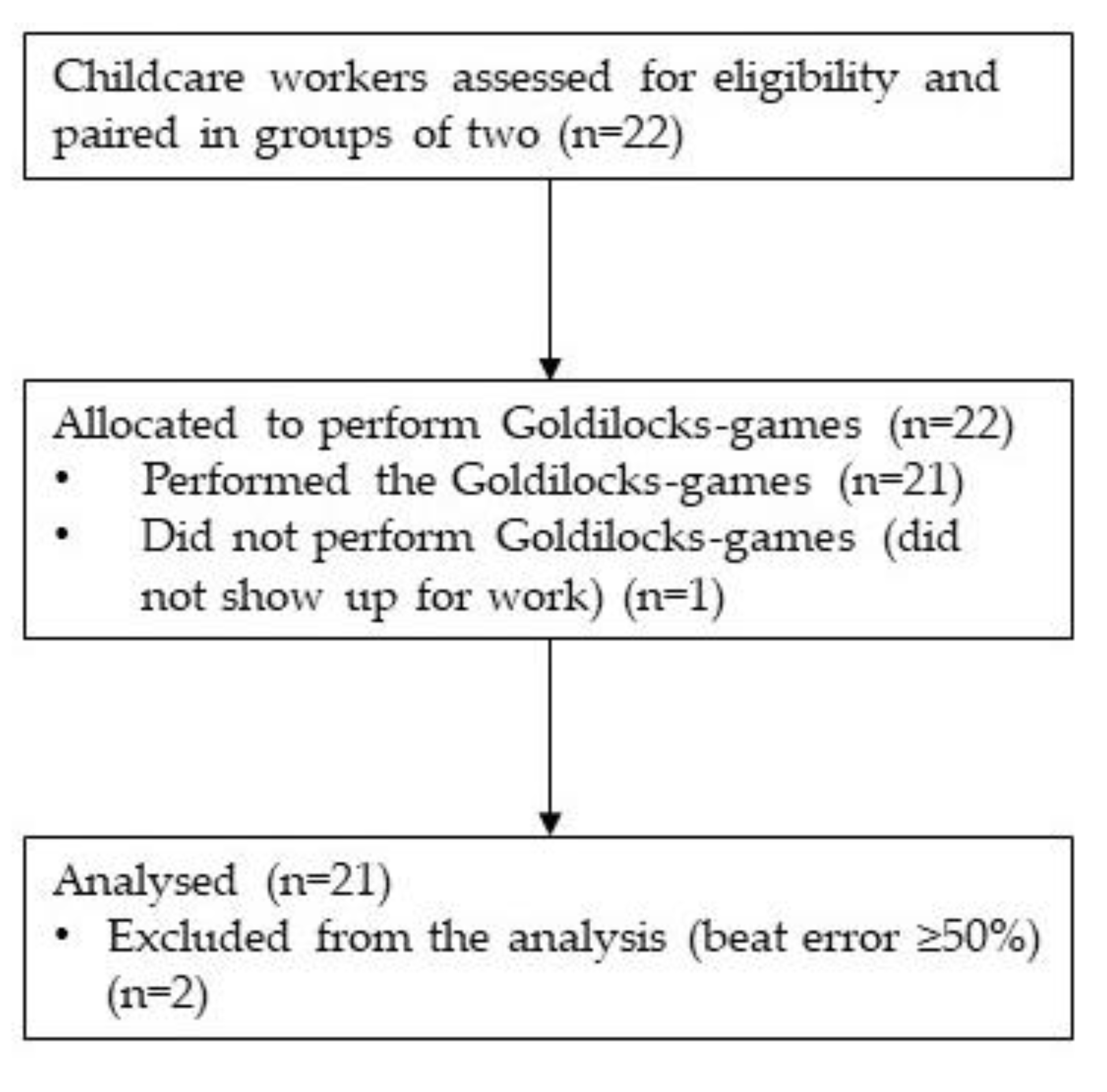
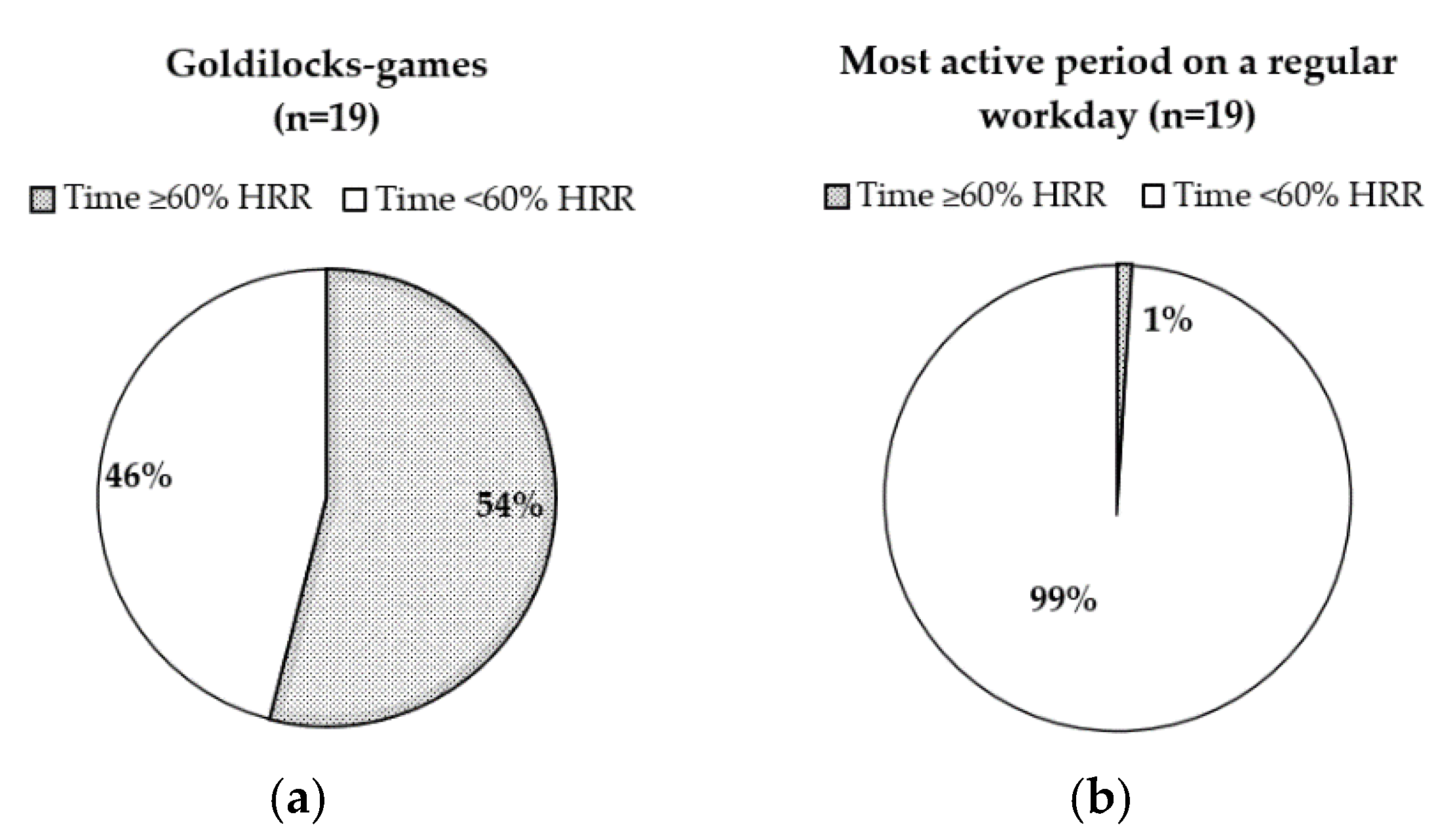
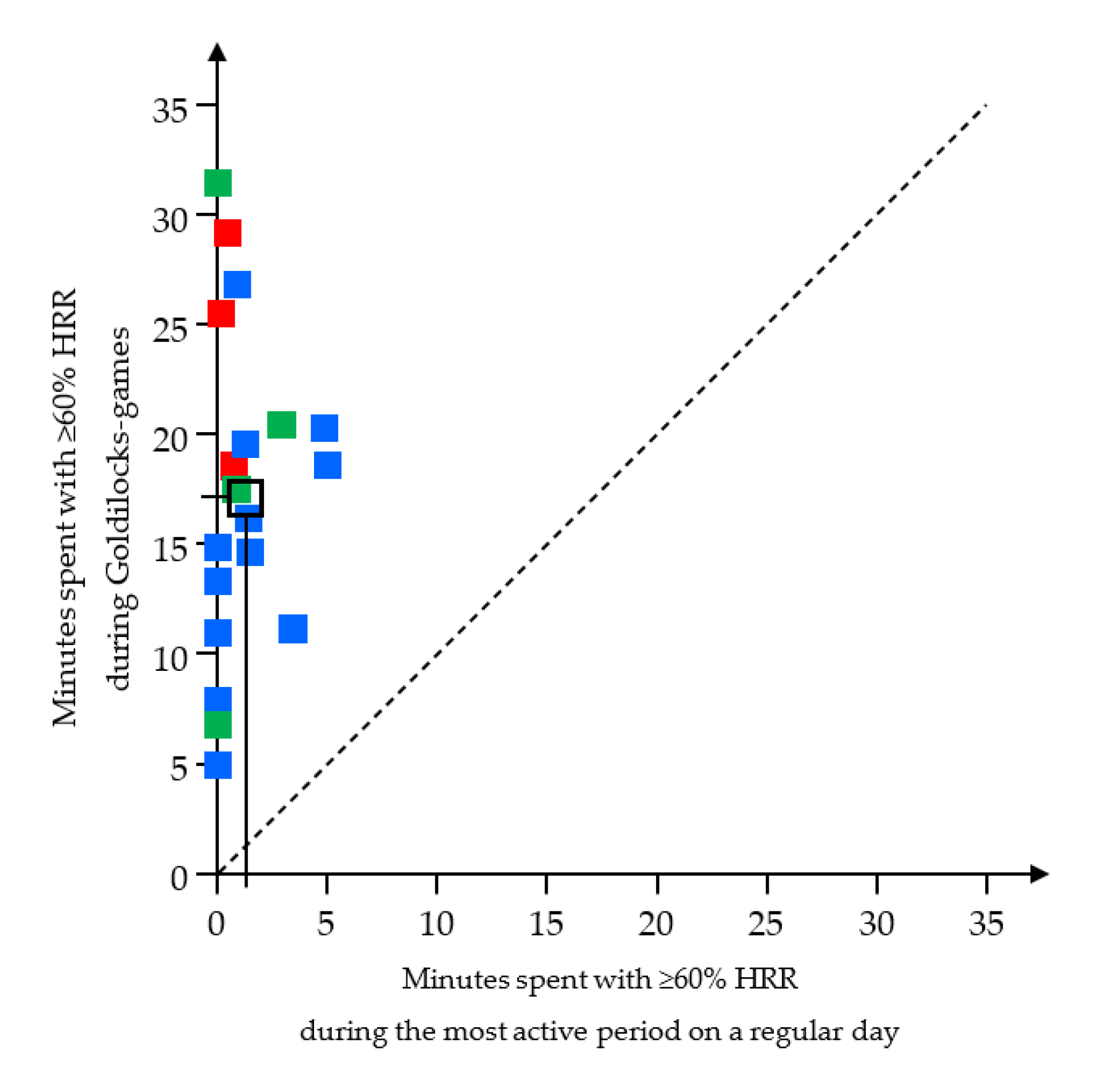
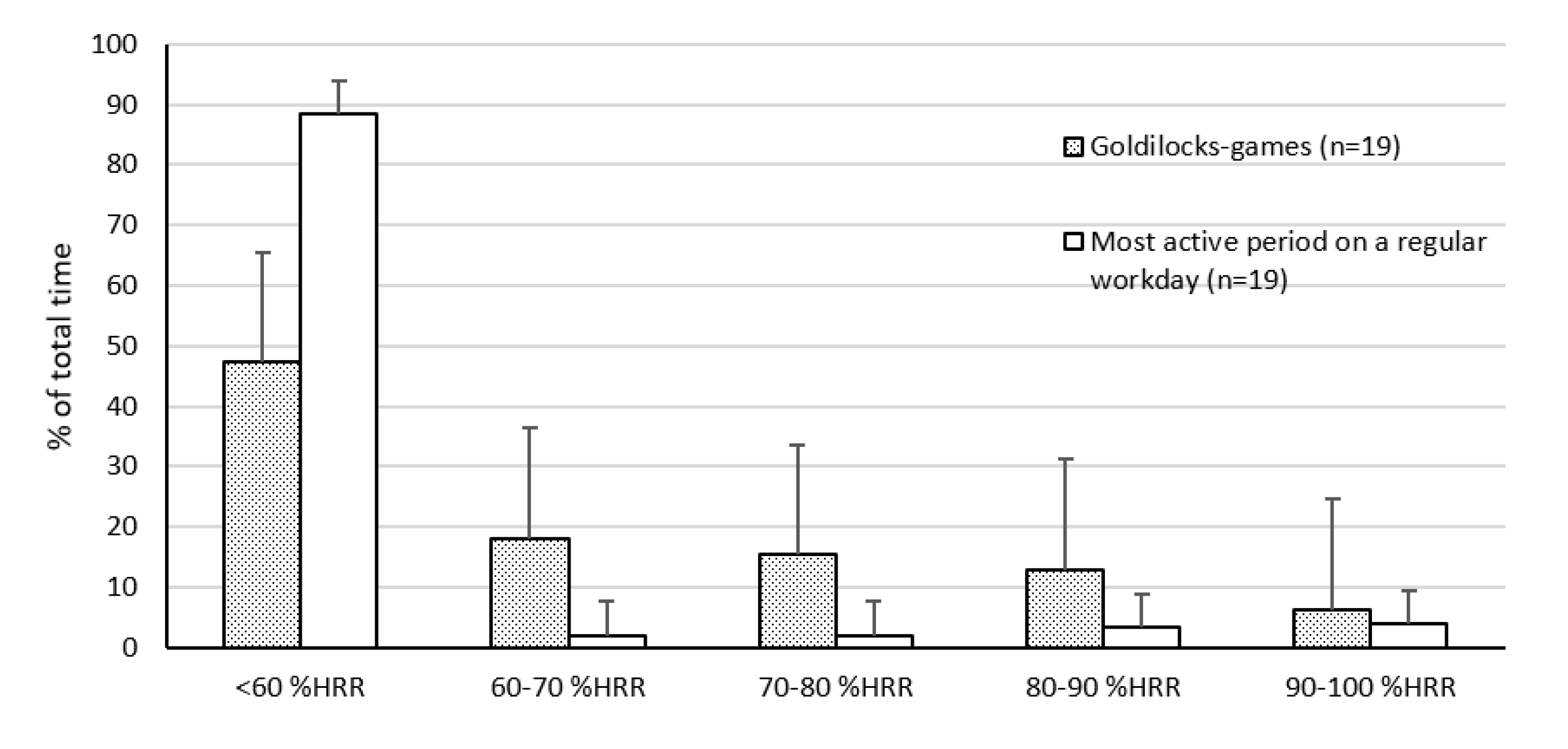
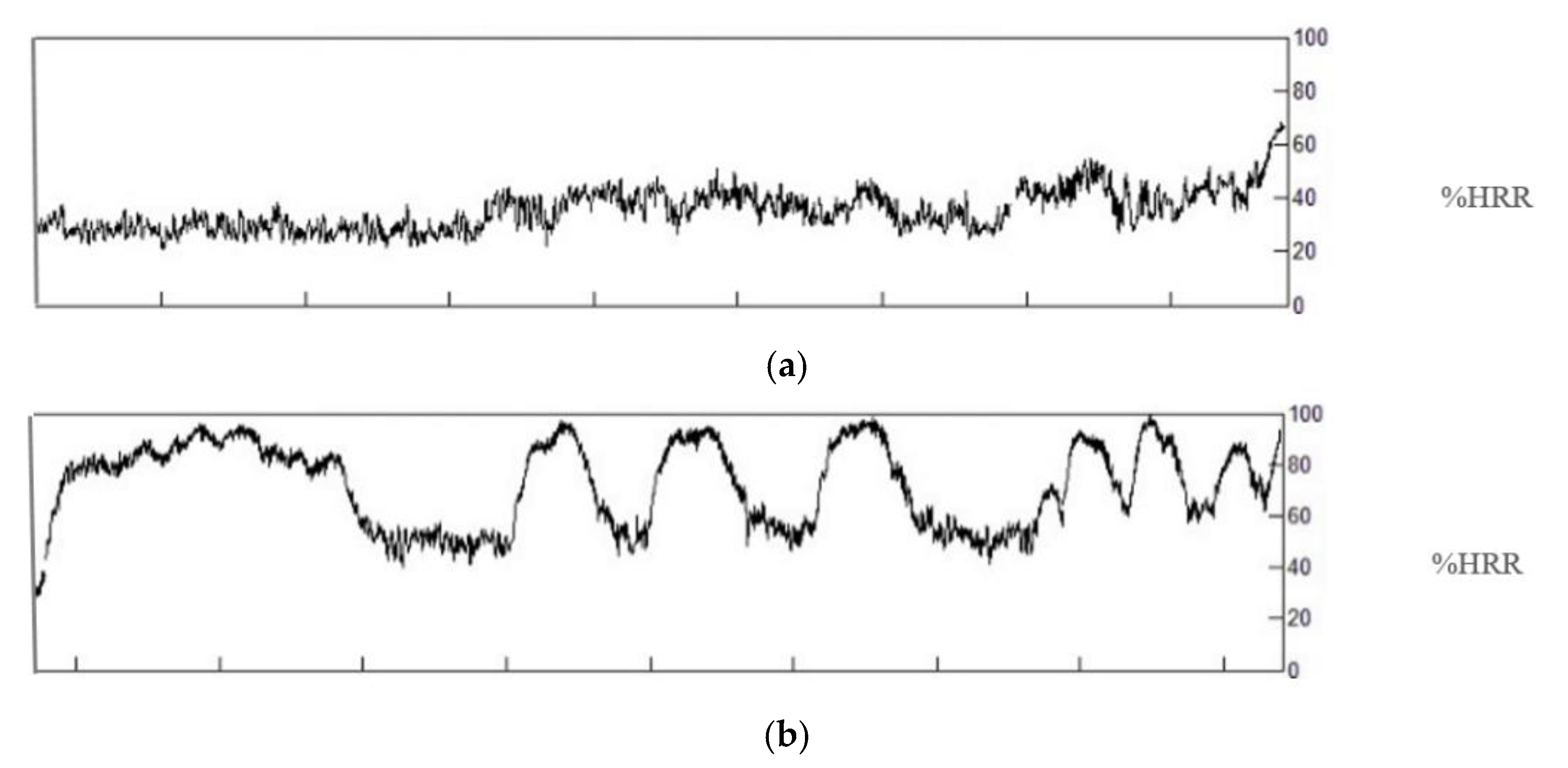
| Variables | N | % | Mean (SD) |
|---|---|---|---|
| Sex (female) | 13 | 68.4 | |
| Age (years) | 35.3 (11.5) | ||
| Length of service in current job | |||
| <3 months | 8 | 42.1 | |
| 12–120 months | 9 | 47.4 | |
| ≥120 months | 2 | 10.5 | |
| Self-rated time spent in MVPA during work and leisure combined (hours/week) | 6.2 (4.4) | ||
| Self-rated time spent in MVPA during work (hours/week) | 1.4 (2.5) | ||
| Self-rated time spent performing VPA during work and leisure (hours/week) | 1.9 (1.7) | ||
| Current smoker (yes) | 7 | 36.8 | |
| BMI (kg/m2) | 25.0 (3.6) | ||
| Blood pressure (mmHg) | |||
| Systolic | 124.9 (10.3) | ||
| Diastolic | 81.8 (8.4) | ||
| Cardiorespiratory fitness (ml/kg·min) | 41.9 (7.9) | ||
| Below average | 3 | 15.8 | |
| Average | 12 | 63.2 | |
| Above average | 4 | 21.1 |
| Variables | % | Mean (SD) |
|---|---|---|
| Pedagogic feasibility a | ||
| Unfeasible | 0.0 | |
| Partially feasible | 26.3 | |
| Feasible | 73.7 | |
| Future implementation b | ||
| Unfeasible | 7.0 | |
| Partially feasible | 21.1 | |
| Feasible | 71.9 | |
| Perceived physical exertion c | 5 (1.4) |
| Contextual Factors | N | % | Mean (SD) |
|---|---|---|---|
| Location a | |||
| Indoor | 0 | 0.0 | |
| Outdoor | 11 | 100.0 | |
| Area b | |||
| Football field | 4 | 36.4 | |
| Playground | 0 | 0.0 | |
| Park | 7 | 63.6 | |
| Area size c | |||
| >100 m2 | 8 | 72.7 | |
| <100 m2 | 3 | 27.3 | |
| Facilities d | |||
| On institutions facilities | 3 | 27.3 | |
| On other facilities | 8 | 72.7 | |
| Easy access e | |||
| Yes | 9 | 81.8 | |
| No | 2 | 8.2 | |
| Weather f | |||
| Sunny | 4 | 36.4 | |
| Cloudy | 6 | 54.6 | |
| Raining | 1 | 9.0 | |
| Duration (min) | 32.5 (8.1) | ||
| Children participating | 13 (4.4) | ||
| Children leaving | 1.5 (2.1) | ||
| Workers’ leaving g | |||
| Yes | 1 | 9.1 | |
| No | 10 | 90.9 | |
| Interruptions h | |||
| Yes | 2 | 18.2 | |
| No | 9 | 81.8 | |
| Adjustments i | 1.3 (0.8) | ||
| Area limitations j | |||
| Yes | 3 | 27.3 | |
| No | 8 | 72.7 | |
| Physical activity among the children k | |||
| High or very high | 3 | 27.3 | |
| Moderate | 8 | 72.7 | |
| Low or very low | 0 | 0.0 | |
| Physical activity among the workers l | |||
| High or very high | 7 | 63.6 | |
| Moderate | 4 | 36.7 | |
| Low or very low | 0 | 0.0 |
© 2020 by the authors. Licensee MDPI, Basel, Switzerland. This article is an open access article distributed under the terms and conditions of the Creative Commons Attribution (CC BY) license (http://creativecommons.org/licenses/by/4.0/).
Share and Cite
Lerche, A.F.; Vilhelmsen, M.; Schmidt, K.G.; Kildedal, R.; Launbo, N.; Munch, P.K.; Lidegaard, M.; Jacobsen, S.S.; Rasmussen, C.L.; Mathiassen, S.E.; et al. Can Childcare Work Be Designed to Promote High Intensity Physical Activity for Improved Fitness and Health? A Proof of Concept Study of the Goldilocks Principle. Int. J. Environ. Res. Public Health 2020, 17, 7419. https://doi.org/10.3390/ijerph17207419
Lerche AF, Vilhelmsen M, Schmidt KG, Kildedal R, Launbo N, Munch PK, Lidegaard M, Jacobsen SS, Rasmussen CL, Mathiassen SE, et al. Can Childcare Work Be Designed to Promote High Intensity Physical Activity for Improved Fitness and Health? A Proof of Concept Study of the Goldilocks Principle. International Journal of Environmental Research and Public Health. 2020; 17(20):7419. https://doi.org/10.3390/ijerph17207419
Chicago/Turabian StyleLerche, Anders Fritz, Maja Vilhelmsen, Kathrine Greby Schmidt, Rasmus Kildedal, Natja Launbo, Pernille Kold Munch, Mark Lidegaard, Sandra Schade Jacobsen, Charlotte Lund Rasmussen, Svend Erik Mathiassen, and et al. 2020. "Can Childcare Work Be Designed to Promote High Intensity Physical Activity for Improved Fitness and Health? A Proof of Concept Study of the Goldilocks Principle" International Journal of Environmental Research and Public Health 17, no. 20: 7419. https://doi.org/10.3390/ijerph17207419
APA StyleLerche, A. F., Vilhelmsen, M., Schmidt, K. G., Kildedal, R., Launbo, N., Munch, P. K., Lidegaard, M., Jacobsen, S. S., Rasmussen, C. L., Mathiassen, S. E., Straker, L., & Holtermann, A. (2020). Can Childcare Work Be Designed to Promote High Intensity Physical Activity for Improved Fitness and Health? A Proof of Concept Study of the Goldilocks Principle. International Journal of Environmental Research and Public Health, 17(20), 7419. https://doi.org/10.3390/ijerph17207419






